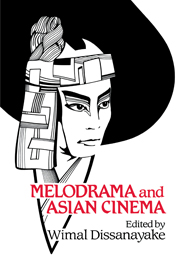Book contents
- Frontmatter
- Contents
- List of contributors
- Acknowledgments
- I Introduction
- II Melodrama / subjectivity / ideology: Western melodrama theories and their relevance to recent Chinese cinema
- III Symbolic representation and symbolic violence: Chinese family melodrama of the early 1980s
- IV The Goddess: Reflections on melodrama East and West
- V Melodrama as historical understanding: The making and unmaking of communist history
- VI Melodrama, postmodernism, and Japanese cinema
- VII Inscribing the subject: The melodramatization of gender in An Actor's Revenge
- VIII Insides and outsides: Cross-cultural criticism and Japanese film melodrama
- IX Psyches, ideologies, and melodrama: The United States and Japan
- X Negotiating the transition to capitalism: The case of Andaz
- XI The concepts of evil and social order in Indian melodrama: An evolving dialectic
- XII Politics of melodrama in Indonesian cinema
- XIII Power, pleasure, and desire: The female body in Filipino melodrama
- XIV The register of nightmare: Melodrama as it (dis)appears in Australian film
- XV Overview: What is American about film study in America?
- Index
XIII - Power, pleasure, and desire: The female body in Filipino melodrama
Published online by Cambridge University Press: 05 June 2012
- Frontmatter
- Contents
- List of contributors
- Acknowledgments
- I Introduction
- II Melodrama / subjectivity / ideology: Western melodrama theories and their relevance to recent Chinese cinema
- III Symbolic representation and symbolic violence: Chinese family melodrama of the early 1980s
- IV The Goddess: Reflections on melodrama East and West
- V Melodrama as historical understanding: The making and unmaking of communist history
- VI Melodrama, postmodernism, and Japanese cinema
- VII Inscribing the subject: The melodramatization of gender in An Actor's Revenge
- VIII Insides and outsides: Cross-cultural criticism and Japanese film melodrama
- IX Psyches, ideologies, and melodrama: The United States and Japan
- X Negotiating the transition to capitalism: The case of Andaz
- XI The concepts of evil and social order in Indian melodrama: An evolving dialectic
- XII Politics of melodrama in Indonesian cinema
- XIII Power, pleasure, and desire: The female body in Filipino melodrama
- XIV The register of nightmare: Melodrama as it (dis)appears in Australian film
- XV Overview: What is American about film study in America?
- Index
Summary
Significance is inherent in the human body.
Julia KristevaLaurey Mulvey's “Visual Pleasure and Narrative Cinema” has shaped much of the current thinking on the representation of women in cinema. However, that essay does not pay adequate attention to the role of the audience and the complex ways in which meanings are negotiated with filmic texts: how viewers' backgrounds, histories, and lived experiences come into play in the production of meaning. The interplay between textual subjectivity (woman) and social subjectivity (women) cannot be ignored, and in our forays into Filipino melodrama we have realized the value of keeping this principle in mind. In this chapter, we examine three Filipino melodramas from the perspective of two Western-educated Asian viewers: one a Filipina and the other a non-Filipino male.
In most national cinemas, the construction of femininity in terms of the human body figures prominently in melodramas, and the Philippines is no exception. In Filipino melodrama in general, the symbolic constitution of womanhood in the filmic enunciation and the discourse on the female body are closely related, bringing into play questions of power, pleasure, and desire. In the present chapter, we demonstrate this by examining two typical Filipino melodramas that narrativize shifting structurations of power, pleasure, and desire within a quintessentially patriarchal social order, denying female subjectivity its ontological validity, and a third film that challenges textual systems that foreground the female body in this way as a means of negating women's autonomy.
- Type
- Chapter
- Information
- Melodrama and Asian Cinema , pp. 218 - 231Publisher: Cambridge University PressPrint publication year: 1993

